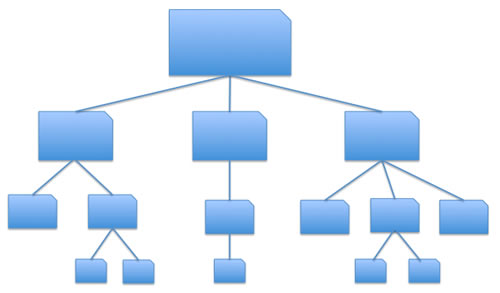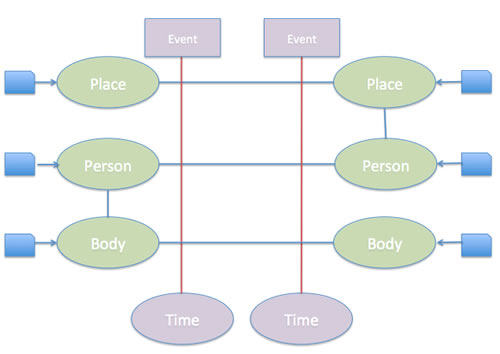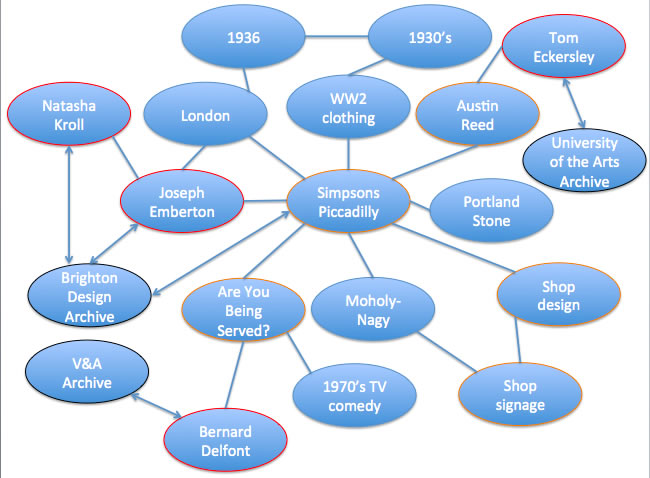At the moment, the Archives Hub takes a largely traditional approach to the navigation and display of archive collections. The approach is predicated on hundreds of years of archival theory, expanded upon in numerous books, articles, conferences and standards. It is built upon “respect des fonds” and original order. Archival provenance tells us that it is essential to provide the context of a single item within the whole archive collection; this is required in order to understand and interpret said item.
ISAD(G) reinforces the ‘top down’ approach. The hierarchy of an archive collection is usually visualised as a tree structure, often using folders. The connections show a top-down or bottom-up approach, linking each parent to its child(ren).

This principle of archival hierarchy makes very good sense. The importance of this sort of context is clear: one individual letter, one photograph, one drawing, can only reveal so much on its own. But being able to see that it forms part of a series, and part of a larger collection, gives it a fuller story.
However, I wonder if our strong focus on this type of context has meant that archivists have sometimes forgotten that there are other types of context, other routes through content. With the digital environment that we now have, and the tools at our disposal, we can broaden out our ambitions with regards to how to display and navigate through archives, and how we think of them alongside other sources of information. This is not an ‘either or’ scenario; we can maintain the archival context whilst enabling other ways to explore, via other interfaces and applications. This is the beauty of machine processable data – the data remains unchanged, but there can be numerous interfaces to the data, for different audiences and different purposes.
Providing different routes into archives, showing different contexts, and enabling researchers to create their own narratives, can potentially be achieved through a focus on the ‘real things’ within an archive description; the people, organisations and places, and also the events surrounding them.

This is a very simplified image, intended to convey the idea of extracting people, organisations and places from the data within archive descriptions (at all levels of description). Ideally, these entities and connections can be brought together within events, which can be built upon the principle of relationships between entities (i.e. a person was at a place at a particular time).
Exploring British Design is a project seeking to probe this kind of approach. By treating these entities as an important part of the ‘networks of things’, and by finding connections between the entities, we give researchers new routes through the content and the potential to tell new stories and make new discoveries. The idea is to explore ways to help us become more fully a part of the Web, to ensure that archives are not resources in isolation, but a part of the story.

For this project, we are focussing on a small selection of data, around British design, extracting entities from the Archives Hub data, and considering how the content within the descriptions can be opened up to help us put it into new contexts.
We are creating biographical records that can be used to include structured data around relationships, places and events. We aim to extract people from the archive descriptions in which they are ‘embedded’ so that we can treat them as entities – they can connect not only to archive collections they created or are associated with, but they can also connect to other people, to organisations, to events, to places and subjects. For example, Joseph Emberton designed Simpsons in Piccadilly, London, in 1936. There, we have the person, the building, the location and the time.
With this paradigm, the archive becomes one of the ‘nodes’ of the network, with the other entities equally to the fore, and the ability to connect them together shows how we can start to make connections between different archive collections. The idea is that a researcher could come into an archive from any type of starting point. The above diagram (created just as an example) includes ‘1970’s TV comedy’ through to the use of portland stone, and it links the Brighton Design Archive, the V&A Theatre and Performance Archive and the University of the Arts London Archive. The long term aim is that our endeavours to open up our data will ensure that it can be connected to other data sources (that have also been made open); sources outside of our own sphere (the Archives Hub data). The traditional interface has its merits; certainly we need to continue to provide archival context and navigation through collections; but we can be more imaginative in how we think about displaying content. We don’t need to just have one interface onto our data. We need to ensure that archives are part of the bigger story, that they can be seen in all sorts of contexts, and they are not relegated to being a bit part, isolated from everything else.
